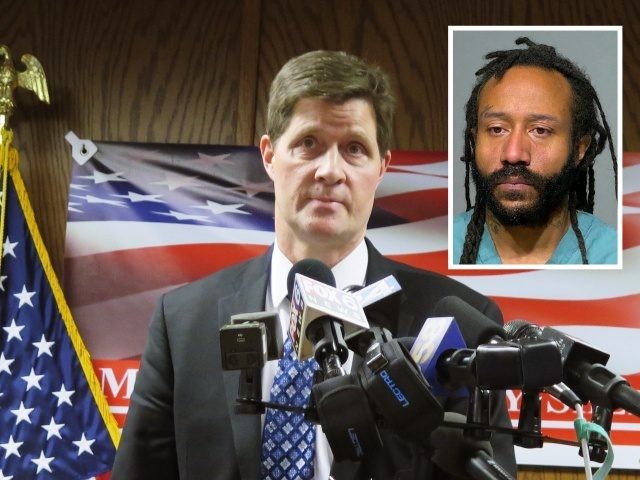Milwaukee District Attorney John Chisholm, a Democrat, was once championed by progressives as a leader on “criminal justice reform” before a court commissioner released the suspect now accused of killing five Americans and injuring 48 others during a Christmas parade in Waukesha, Wisconsin.
On Sunday, police allege that 39-year-old Darrell E. Brooks Jr. mowed down a crowd at Waukesha’s annual Christmas parade — killing five and injuring dozens more. Brooks is expected to be charged with five counts of first-degree intentional homicide.
Brooks has an extensive criminal history, totaling 16 arrests since 1999, and has been repeatedly released from police custody on bail. In the latest case, earlier this month, Brooks was charged with second-degree recklessly endangering safety, felony bail jumping, battery, obstructing an officer, and disorderly conduct.
A woman has claimed that Brooks mowed her down with his vehicle in a gas station parking lot after the two got into a domestic dispute.
For the charges, Milwaukee County Court Commissioner Cedric Cornwall set Brooks’s bail at $1,000. He posted the bail on November 11 and was released from police custody.
Soon after Brooks’s arrest, Chisholm’s office released a statement calling the $1,000 bail “inappropriately low” and has suggested that an internal investigation is being conducted at the district attorney’s office to review how and why the bail was set at such a low amount.
The case is seemingly in line with Chisholm’s record as a progressive former prosecutor who has been championed in the past for his work on so-called criminal justice reform efforts to release more inmates from prison and reduce overall incarceration rates.
In 2015, Jeffrey Toobin profiled Chisholm’s work as a “national leader” on criminal justice reform for the New Yorker in a piece titled “The Milwaukee Experiment: What can one prosecutor do about the mass incarceration of African-Americans?”
The New Yorker profile notes:
Chisholm decided that his office would undertake initiatives to try to send fewer people to prison while maintaining public safety. “For a long time, prosecutors have defined themselves through conviction rates and winning the big cases with the big sentences,” Nicholas Turner, the president of the Vera Institute, told me. “But the evidence is certainly tipping that the attainment of safety and justice requires more than just putting people in prison for a long time. Prosecutors have to redefine their proper role in a new era. Chisholm stuck his neck out there and started saying that prosecutors should also be judged by their success in reducing mass incarceration and achieving racial equality.” Chisholm’s efforts have drawn attention around the country. “John is a national leader in law enforcement, because he is genuinely interested in trying to achieve the right results, not only in individual cases but in larger policy issues as well,” Cyrus R. Vance, Jr., the Manhattan District Attorney, told me. [Emphasis added]
…
Chisholm decided to move to what he calls an evidence-driven public-health model. “What’s the most effective way to keep a community healthy?” he asked. “You protect people in the first place. But then what do you do with the people who are arrested?” There are two basic models of prosecutorial philosophy. “In one, you are a case processor,” he said. “You take what is brought to you by law-enforcement agencies, and you move those cases fairly and efficiently through the system. But if you want to make a difference you have to do more than process cases.” [Emphasis added]
So Chisholm began stationing prosecutors in neighborhoods around Milwaukee. “If people view prosecutors as just the guys in the courthouse, who are concerned only with getting convictions, then you are creating a barrier,” he said. He and his team started asking themselves in every instance why they were bringing that case. “In those that were seen as minor, it was the least experienced people who were deciding whether to bring them. And these people saw that we had generally brought those cases in the past, so they went ahead with them again. But we started to ask, ‘Why are we charging these people with crimes at all?’” [Emphasis added]
At the time of the profile, Chisholm’s office bragged that Milwaukee County was mostly the reason for the state’s drop in its prison population. In 2007, Wisconsin’s prison population totaled about 24,500 inmates. By 2015, that had been reduced to about 22,000 almost exclusively thanks to Milwaukee County, according to the New Yorker.
In similar statements made in 2015, Chisholm suggested that more policing and more criminal convictions were not a solution to reducing overall crime rates.
“We have to get away from the concept that all the problems that exist in the community can somehow be funneled into the criminal justice system and that system will solve all the problems,” Chisholm said at an event with criminal justice reform advocates.
“It just hasn’t worked,” Chisholm said. “In concentrated areas of our community for 20 to 30 years now, we’ve gotten the same bad results. …We’re not going to solve the problems by sending more cops and charging more cases.”
John Binder is a reporter for Breitbart News. Email him at jbinder@breitbart.com. Follow him on Twitter here.

COMMENTS
Please let us know if you're having issues with commenting.